The Catholic Church stoles for the Liturgy are one of the fundamental pieces within the vestments of a minister of the Church. Buying a stole has never been so simple; we have for sale priestly stoles, embroidered or unembroidered stoles in the four liturgical colors : red, white, purple and green, fringed stoles, etc. at the best prices.
As a liturgical element of Catholic clothing, stoles are a cloth garment worn by priests, deacons, presbyters, and bishops around the neck during liturgical celebrations.
The materials of manufacture and the liturgical colors are equated to those of the chasubles .
The stole is a band of fabric that priests, deacons, or the bishop hangs from the neck over the chest, secured with a cincture over the alb.
Bishops and priests wear it hanging from the neck forward under the chasuble. In the case of deacons, the stole is placed over the left shoulder in the front and behind towards the right side of the waist, also secured with a cincture over the tunic and under the dalmatic.
The length of the stole should be sufficient so that, when passing around the neck and crossing in front of the priest's chest, each end, held on both sides by the cincture, can fall and hang.
According to the liturgical calendar, the stole must be the same color as the chasuble or the dalmatic.
The stole has an undetermined origin, like most garments and liturgical ornaments with several centuries of history. There are different versions of the adoption of the stole as a liturgical ornament of Catholic priests.
Today, one of the most widespread theories is that the stole, as a Christian liturgical ornament, comes from a garment known as orarium. A piece of fabric used around the neck. Its original function was related to hygiene, as wearers used it to wipe their faces or sweat. The Jews adopted it and gave it a religious character, utilizing the orarium as a garment for prayer.
Approximately in the 12th century, the word orarium began to be replaced by the Greek term stolé (στολή ("dress")). The Greek term would evolve into the term we commonly.
The priestly stole is one of the liturgical vestments worn by clergy members during religious celebrations. The stole for priests carries profound symbolism and meaning within the Christian faith.
The stole serves as a visible symbol of the priest's role within the community. It serves as a reminder for both the priest and the faithful that the person wearing the stole represents Christ on earth.
The shape of the stole represents God's yoke for priests. It is a reminder that priests are in service to the Word of God. Not only as evangelists and disseminators of the teachings of Our Lord but also as human examples of Christian conduct.
The stole symbolizes the priest's role as a mediator between God and the people. It is a means for the priest to remember his sacred duty as a guide for the faithful and a behavior model within the community.
As a liturgical vestment, the stole has a specific form ordained by the Church. It is a long, narrow strip of fabric placed over the shoulders of the priest, hanging forward over the priest's chest.
It is customary for the front part to be adorned with all kinds of religious elements, from Marian embroideries related to the Virgin Mary to Eucharistic embroideries such as the Sacred Host, chalices, sheaves of wheat, bunches of grapes, etc.
At times, the area of the garment that goes around the priest's neck may bear some vestments with crosses.
They may also include some fringe at the ends of the garment. The fringes can vary in size and characteristics, but they often have golden cord fringes. Some Marian stoles are adorned with silver or white fringes.
Stoles can be made from various fabrics. It is common for them to be made of synthetic materials such as polyester or polyester blends with other types of fabrics.
The measurements of stoles can vary slightly.
Larger stoles, sometimes called stolons, can reach almost three meters in length, including the fringes. They usually have a maximum width between 15 and 16 centimeters.
Smaller stoles, known as travel stoles or Sacrament portfolio stoles, are typically about 11 cm wide and approximately two meters long. These types of stoles are beneficial when the priest must administer sacraments or conduct liturgical celebrations away from his parish.
An important aspect of the stole is its color, which conveys different meanings according to the liturgical season. The colors used in stoles are rich in symbolism and help highlight certain aspects of the liturgical time.
The priest aids the faithful in immersing themselves in the mysteries of each liturgical season by wearing the corresponding colors. It fosters the understanding and connection of the Christian community with the messages of the liturgical season.
white is often associated with purity, innocence, joy, and the light of God's presence. Additionally, it is a color related to the Virgin Mary, one of the figures who best represents purity.
Priests wear white stoles during Christmas and Easter liturgical celebrations, commemorating the Birth and Resurrection of Jesus Christ, respectively.
Feasts of the Virgin Mary, honoring her immaculate conception, divine motherhood, and assumption into heaven.
Sacraments of Baptism, Confirmation, Anointing of the Sick, Holy Orders, and Matrimony, which are signs of God's grace and communion with Him and the Church.
Feasts of Jesus Christ, such as Epiphany, Transfiguration, Corpus Christi, or Ascension, revealing His glory and saving mission.
Feasts of Angels and Saints who were not martyrs, serving as models of holiness and fidelity to God.
Additionally, priests may wear white stoles on other occasions such as All Saints' Day, the feast of St. John the Baptist, the feast of St. John the Evangelist, the feast of the Chair of St. Peter, or the feast of the Conversion of St. Paul.
Green is often associated with renewal and hope. It symbolizes life and vitality found in nature, reminding us of God's continuous presence and life cycle.
The color green is commonly seen during Ordinary Time, which occurs outside major liturgical seasons like Advent, Christmas, Lent, and Easter.
During Ordinary Time, the Church focuses on the teachings and ministry of Jesus, and green serves as a reminder of continuous spiritual growth and development within the Christian community.
Red stoles are worn on feasts related to the shedding of blood (the sacrifice and martyrdom of Christ or other Holy Martyrs) and the Holy Spirit.
Priests may wear red stoles on two days of Holy Week. Firstly, on Palm Sunday, the day of Jesus' triumphal entry into Jerusalem before His arrest, martyrdom, and death. Secondly, on Good Friday, the day on which Jesus of Nazareth was crucified and died on Golgotha.
Related to the shedding of blood, priests may also wear red stoles on feasts related to the Apostles, the Evangelists, or the Holy Martyrs who died for the love of Jesus Christ.
Besides liturgical celebrations related to the shedding of blood, red is the color of the Holy Spirit. Therefore, pastors may wear red stoles during liturgical celebrations linked to the Holy Spirit, especially on Pentecost.
On the feast of Pentecost, Catholics celebrate the coming of the Holy Spirit upon the apostles and the Church.
purple symbolizes solemnity, penance, reflection, inner analysis, and preparation.
In Christianity, purple is commonly used during the liturgical seasons of Advent and Lent. Both periods are moments of reflection and repentance for errors and sins committed. They are times of preparation for the Birth and Resurrection of God.
Purple reminds us to prepare our hearts for the Birth of Jesus during Advent.
In Lent, purple reflects the meditation we must undertake to prepare for Holy Week. The journey toward the crucifixion begins on Palm Sunday and culminates with Easter Sunday Resurrection.
Purple stoles are also worn on other days such as Epiphany, Holy Week, etc.
Blue stoles are linked to feasts of the Virgin Mary.
Blue represents her purity, humility, and fidelity, reminding her of her role as the Mother of God and her unwavering devotion to her son Jesus.
Originally, the color blue was used during the day of the Immaculate Conception. The use of blue garments has extended to all kinds of Marian celebrations.
Pink stoles represent joy and hope. The color pink in the Catholic Church is linked to joy within sobriety, as it is usually worn on the third Sunday of Advent (Gaudete Sunday) and the fourth Sunday of Lent (Laetare Sunday).
The color pink serves as relief during the penitential seasons of Advent and Lent, marked by violet. Pink represents joy at the upcoming arrival of Jesus during Advent and Lent. It serves as a reminder that penance is necessary to attain the joy of Jesus' presence.
Buying or gifting a stole to a priest is a process that must consider various important aspects.
The enumerated sections below will determine the final purchase price of the vestment.
Firstly, the material of the stole plays a significant role in determining its price. Stoles can be made from various materials, such as polyester, brocade, etc.
The fabric price used to make the garment will determine the price of the final product.
The design of the stole's ornamentation also significantly influences the final selling price of the garment.
Stoles embroidered with a simple element like a flat cross will be cheaper than those with a more complex figure, such as the Virgin of Mount Carmel.
Besides the complexity of the embroideries, the number and size of embroideries influence prices. More embroideries and larger embroideries result in higher prices.
The size of stoles is another factor to consider. Larger stoles, stolons, are usually more expensive than smaller stoles.
Reversible stoles, also known as double stoles, are a versatile liturgical accessory many priests buy for parish work.
Double or reversible stoles are garments with two faces; they can be used in two independent ways. They usually have one liturgical color on one side and another on the other.
This allows the priest to quickly adapt the stole to match the liturgical season or occasion. With a simple twist, the stole can go from violet for Advent and Lent to white for Christmas and Easter.
Customized stoles are another option to consider when buying or gifting a stole to a priest.
This product allows for complete personalization. You can purchase a stole with the desired material, embroidery, and measurements.
Custom-made stoles with personalized designs are more expensive than standard stoles on our online store.
The Marian stoles and scapulars are liturgical ornaments used by priests to officiate celebrations during feasts linked to the Virgin Mary, such as the feast of the Immaculate Conception of Mary.
Like the chasubles, Marian stoles and scapulars are usually white or sky blue. They are normally embroidered with Marian elements related to the Virgin Mary (lilies, symbol of the Virgin Mary, etc…) and/or Marian elements associated with a specific devotion (Our Lady of Fatima, Our Lady of Lourdes, etc…).
Stolons and priestly stoles have an important liturgical meaning. They symbolize the cleric's sacred powers as a shepherd who carries his sheep on his shoulders and guides souls to eternal life.

Ref: 84R006
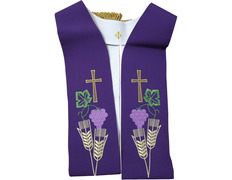
Ref: 84R006

Ref: 84R006

Ref: 84R006

Ref: 56B800

Ref: 1F3010

Ref: 56C714
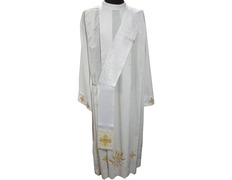
Ref: 84F47D
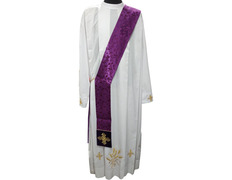
Ref: 84F47D
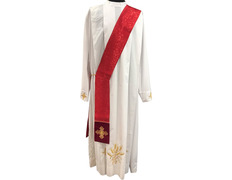
Ref: 84F47D
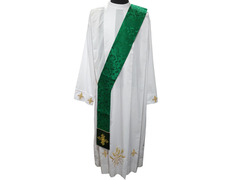
Ref: 84F47D

Ref: 52F712

Ref: 52F729

Ref: 52F729

Ref: 52F743

Ref: 52F743

Ref: 52F788

Ref: 52F788
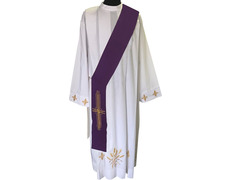
Ref: 52F218

Ref: 52F218
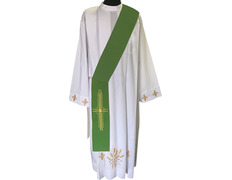
Ref: 52F218

Ref: 84B025

Ref: 1F3006

Ref: 52F732

Ref: 52F732
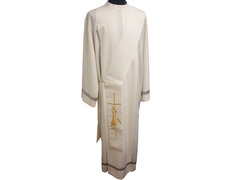
Ref: 84F202
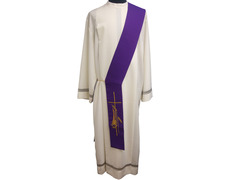
Ref: 84F202
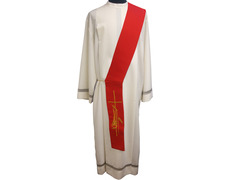
Ref: 84F202

Ref: 84F202

Ref: 84B802

Ref: 56B051

Ref: 56B282

Ref: 1F3005

Ref: 1F3005

Ref: 1F3005

Ref: 1F3005

Ref: 1F3006

Ref: 1F3006

Ref: 1F3006

Ref: 1F3010

Ref: 1F3010

Ref: 1F3010

Ref: 1R3004

Ref: 1R3004

Ref: 52F713

Ref: 52F713

Ref: 52F713

Ref: 84F011

Ref: 84F011

Ref: 84F011

Ref: 84F011

Ref: 84F003

Ref: 84F003

Ref: 84F003

Ref: 84F003

Ref: 56B800

Ref: 56B800

Ref: 56B800

Ref: 84B3C2

Ref: 84B3C2

Ref: 52F788

Ref: 52F788

Ref: 1R3004

Ref: 56B281

Ref: 56B281

Ref: 56B281

Ref: 84B542

Ref: 52F790

Ref: 56B286

Ref: 56B287

Ref: 56B285

Ref: 56B283

Ref: 84F012MA

Ref: 1R3004

Ref: 52F713

Ref: 84B3C1

Ref: 84B3C1

Ref: 56B281

Ref: 52F218

Ref: 84R002

Ref: 84R002

Ref: 84R002

Ref: 84R002

Ref: 1F3011

Ref: 1F3011

Ref: 1F3011

Ref: 1F3011